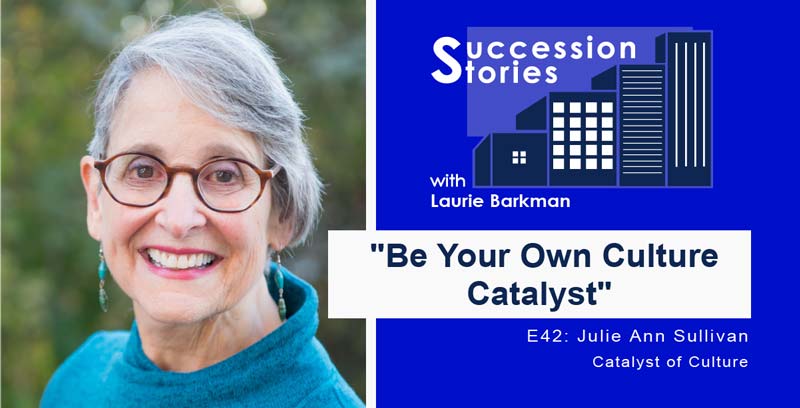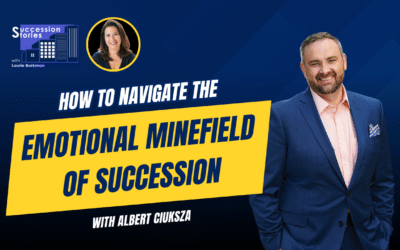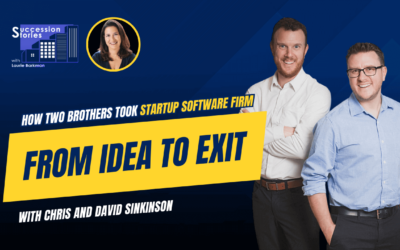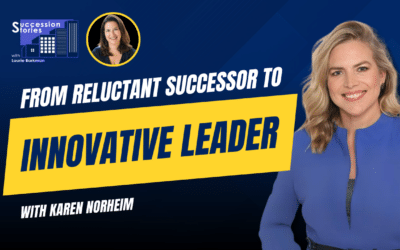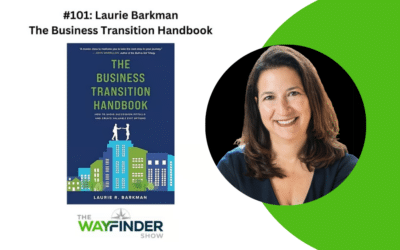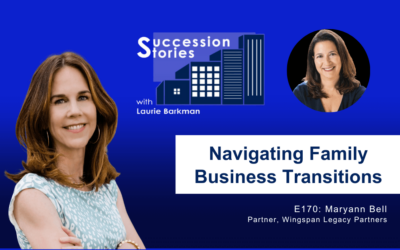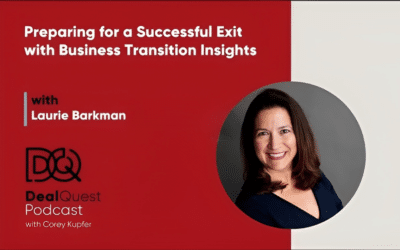Laurie Barkman is joined by Julie Ann Sullivan, an international best-selling author, speaker, and business culture expert. What’s the big “why” around company culture? First it’s dollars. Morale and attitudes affect employee productivity, which can negatively affect your customer service, quality, reputation, and ultimately your profits. The other “why” is related to succession. You need a good culture for your company to thrive without you one day. Listen in for actionable ideas for creating a positive and productive culture in your business.
Listen in to learn more about:
- Understanding the attributes of your company culture
- How to tie your purpose to your company culture
- Harnessing the power of gratitude both at a personal and professional level
- Transforming culture by linking gratitude with company values
- The multiplier effect of culture on your brand
- Behaviors leaders can emulate for success
Show Links
https://www.linkedin.com/in/julieannsullivan
Catalysts of Culture book on Amazon
Episode Transcript
Laurie Barkman:
Welcome to Succession Stories insights for next-generation entrepreneurs. I’m Laurie Barkman. I’ve spent my career bringing an entrepreneurial approach to mature companies struggling with change. As an outside executive of a third-generation 120-year-old company, I was part of a long-term succession plan. Now I work with entrepreneurs privately held companies and family businesses to develop innovations that create enterprise value in transition plans to achieve their long-term goals. On this podcast, listen and while I talk with entrepreneurs who are driving innovation and culture change, I speak with owners who successfully transition their company and others who experienced disappointment along the way. Guests also include experts in multi-generational businesses and entrepreneurship. If you are a next-generation entrepreneur, looking for inspiration to grow and thrive, or an owner who can’t figure out the best way to transition their closely held company, this podcast is for you.
Subscribe to our newsletter for more resources to build value in your business, visit smalldotbig.com and sign up today.
This week I’m joined by Julie Ann Sullivan, an international best-selling author, speaker, and business culture expert. What’s the big “why” around company culture? First it’s dollars. Morale and attitudes affect employee productivity, which can negatively affect your customer service, quality, reputation, and ultimately your profits. The other “why” is related to succession. You need a good culture for your company to thrive without you one day. Listen in for actionable ideas for creating a positive and productive culture in your business.
Laurie Barkman:
I am so excited today to speak with Julie Ann Sullivan. She’s a catalyst of culture and it’s an amazing thing to talk about culture because it’s hard to put your finger on it. So Julie Ann, I’m really glad to have you on today — because I think, especially now as companies are really going through a lot of changes — to talk about the topic of culture. So welcome to Succession Stories.
Julie Ann Sullivan:
Oh, thank you so much, Laurie, I’m really excited to be here today as well.
Laurie Barkman:
Why don’t we start by talking about you and your background? Because you didn’t start out as a catalyst of culture. You started out as a CPA, right?
Julie Ann Sullivan:
Well, actually, before that I have a degree, my undergraduate degree is in psychology and I was interested in developmental psychology and made a pact with myself, right after I graduated with my BA to learn about human behavior every day deliberately in some way, which I have continued. Then I ran away to a ski resort for seven years. Then when I came down off that mountain, I got my MBA in accounting, and was an accountant for decades, and in many, many different roles and then I didn’t want to learn any more about it. So I quit, and I thought about the unique perspective I had between understanding how functionally a business works, and how well I understood human beings. At the same time, life would have it, this new phrase came out called employee engagement. So it was a perfect path for me to follow.
Laurie Barkman:
Yeah, absolutely. Well, that’s an interesting path when you talk about paths and mountains being running a ski resort and doing all these different things and finally finding this path to employee engagement. Psychology is an interesting beginning for you. I’ve always thought about the psychology of business. It’s what I studied undergrad, and my undergrad was what I called the psychology of business with human resource management. My major was a major that put us into either labor relations, law, or human resource management, and so for me and working in that field, employee engagement was just part of what we did. I’ve inherently, since the beginning of my career, understood the value of having people engaged in their workplace. But there might be people wondering, what’s the big “Why”? Why does company culture matter? Why does employee engagement matter?
Julie Ann Sullivan:
Well, it only matters if: A, you want to hire really good talent, B, if you want to retain that talent, C, if you want a workforce that can be flexible and creative, and D, if you want to have a bigger profit.
Laurie Barkman:
Yeah, I think that all of those things matter. Right?
Julie Ann Sullivan:
Exactly, and in the last 10 years, companies are starting to realize that having a happy, fulfilled team member is better for every part of your business. I have to mention Laurie, right now a lot of people are shying away from caring about culture, but as we get through this, and I won’t say things are going to go back to normal, because they’re going to be different, but the talent pool, which has been shrinking for years, is going to shrink even more. If you think about the fact that one of the few areas that have increased through this pandemic, is people starting their own businesses and I used to say 10 years ago, there was no degree in entrepreneurship, now you can go to school and get a degree in entrepreneurship. People have experienced running their own businesses, so talent is going to be even scarcer than it was before, and you’re dealing with people who are going to say, “I don’t want to work somewhere where people don’t care about me,” and culture is a way to show your workforce that you care.
Laurie Barkman:
Absolutely, and there’s a way to quantify everything you just talked about. You can quantify the cost of retention problems.
Julie Ann Sullivan:
Oh, yeah.
Laurie Barkman:
You can quantify the challenge of filling jobs in a timely fashion, you can quantify the productivity, and I think the number I might have found on your website is staggering – $50 billion annual basis. It’s a big, big number if you don’t address it. Not to mention lawsuits, if you really want to go on the other side of the coin.
Julie Ann Sullivan:
Correct, because engagement and culture also affects — I named four of them, but there’s a lot — but it also affects safety and quality in a workplace.
Laurie Barkman:
Absolutely, and how you treat each other matters. Let’s face it, people want to know that you care about them and culture is a big part of that, so let’s talk about purpose. I think that for a lot of companies, it starts there. They need to define what their purpose as a company is, why do they exist? What do they do? In your experience, how would you tie together purpose and how does it influence a company’s culture?
Julie Ann Sullivan:
Well, I’m not sure which comes first; the chicken or the egg, but there’s a two-fold purpose that I think it’s the responsibility of leadership for every team member to know Simon Sinek talks about “the big why” and this is tied into that. There is a purpose of what you do every day. What is it that you do? I make calls, I fill out forms, I create graphics, whatever your job is, but there is a greater purpose for what the company does. I’ll just give you one example. If you’re a real estate agent, you sell homes. That’s what you do but you’re creating future dreams and memories for people. That’s the bigger purpose of what you do. When people know what that is — and there’s many ways to do that in a in an organization — when people do that, they have a different mindset about how they’re doing their work and so that’s where purpose really comes in, and repetition and conversation, communication on a regular basis about what that overall purpose is, changes the culture of a workplace.
Laurie Barkman:
Let’s talk about culture. How does a company understand what the attributes of their culture is? How do they even know how people describe them? How do they measure that?
Julie Ann Sullivan:
I always say if you haven’t deliberately done work to create a culture, then there’s a culture already that’s been created for you, and the best way to do that is ask talk, take a survey, have a consultant come in and find out for you. Find out what your workforce thinks and what they would like. I’d say the biggest part of my work is making a plan because culture is so big, and like any kind of challenge, when it’s really big, makes people freeze and do nothing. One of my best attributes is being able to cut everything down into bite size pieces. Create a plan with this small step, then this small step then this small step, giving people a direction to continually move forward. I think that’s the toughest piece and then for people who have been working on their culture already, sometimes they need fresh eyes, fresh perspectives to help them see something new and sometimes that comes from their workforce.
Laurie Barkman:
I was gonna ask you — that leads me to this next question — what would be some of those reasons that a company has brought you in? Is it because they’re having a problem with their culture or because they see a need for change? Or maybe like you said, their employees, or there’s something that’s come up where employees are calling out a problem?
Julie Ann Sullivan:
One is being able to hire good talent, “Why isn’t good talent coming our way?” I had a company that I dealt with, and they were having that problem, and basically, I said, “You have old, all middle-aged white men on your website and yet you have women who are in leadership positions, and you’re not showing that on your website. You’re not showing any diversity, even though you have diversity in your company. If I am a young adult now going to look and I see that I’m not even going to apply.” So that’s just one small example. They may be having problems getting good talent. They may have a high turnover rate. It can’t always be everybody else, right? It can’t always be a generational problem. That may be a reason, or they may have had a change in leadership, or an awakening by leadership that says, “We need to work on this, we can’t just have this be willy nilly. We need to bring everyone in and create our own tribe, our own family, our own community, that is our brand.” Because the interesting aspect of culture is it is your brand. It’s what people say, at the local bar, at a restaurant when we can get back there. It’s what people say to one another about your business, that’s your brand, and that very much so comes from inside your culture.
Laurie Barkman:
That’s right, because a lot of people if they enjoy working there, they’re going to tell everybody how much they enjoy working there. They’re going to foster referrals to jobs that are open and business. They’re going to drive customers there. I felt that way very strongly about a company I used to work for. I used to wear their clothing. I used to tell everybody how proud I was, how much I loved the environment there. That’s a multiplier effect if a lot of other employees feel that way…
Julie Ann Sullivan:
Absolutely.
Laurie Barkman:
…and so for you, you’ve worked with a lot of different organizations from global multinational corporations, to smaller organizations. As you reflect on any of those clients, which organization has most impressed you, by the changes that they’ve made to their culture, from a before and after story?
Julie Ann Sullivan:
I think I would have to say, the Dwyer Group, which is now a part of Neighborly, and they had this way, they decided to come up with a set of values and at every meeting where they had three or more people, they would recite them or discuss one. So think about that every meeting with three or more people. It took about a minute, this wasn’t a long discussion or anything like that. They actually used to give out gift cards and T-shirts for people who could recite them with heart is what they said. Now, their revenue when they started this program, their revenue doubled in two years. So that’s the best example I can come up with. Was it because of that? I don’t know, but did that have something to do with it? I would think so.
Laurie Barkman:
I would think so too. How did the leadership emulate the values that they espouse in that particular company?
Julie Ann Sullivan:
It’s really great, because Mary used to say, one of the values that she had a more difficult time doing well was getting packed to people in a timely manner, and they had such a unique culture that people could basically come up to her — she was, I think, the CEO at the time — and bust her for it…
Laurie Barkman:
…and she’d take it.
Julie Ann Sullivan:
She’d take it, right. So that in itself is an amazing culture. Right?
Laurie Barkman:
Yeah, to have the courage to go to an executive and say, “Hey, you’re not living in the valley.”
Julie Ann Sullivan:
They emulated it by doing it and of course, if you don’t have buy in from the C-suite, and you’re just…it’s the same thing, you can’t ask people to do something you’re not willing to do yourself.
Laurie Barkman:
Right. People see through that.
Julie Ann Sullivan:
More and more. The days of “Just come in and do your job” are over and the idea of leaving your personal life at home, which nobody ever did anyway, are over. You’re dealing with a whole human being in your workforce; you’re not dealing with somebody who’s just doing what you want them to do. Now, are there companies out there still? Absolutely.
Laurie Barkman:
Well, I mean, for even you and I, for this podcast, I know the name of your dog is “Joy” and she brings you joy every day.
Julie Ann Sullivan:
Everybody knows Joy. In fact, around my neighborhood they go, “Bye, Joy!” It’s like, “Hey, I’m here too.”
Laurie Barkman:
They know her more than they know you. Well, you had mentioned that being authentic and having people, in this story you shared, people calling out the COO for her behaviors. That’s an important aspect. What are some other behaviors? Particularly now, what are important behaviors for leaders now, at this time still very much in the heart of the pandemic, where a lot of companies are still remote, what can leaders do to emulate behaviors for success?
Julie Ann Sullivan:
I go back to the four attributes I found in common with the many dozens of C-suite leaders that I interviewed for my own podcast over the past several years. Number one on the list to me, because I’m a communications freak, was the ability to really listen. People either know how to do that, or they don’t; they’ve never been taught how to, so many times, when I do communication work, it is on listening. How to really listen and then once you have that ability, coupled with the ability to be open to new ideas, will catapult any business as opposed to C suite leadership that believes they have all the answers, right? That’s very short sighted. A lot of times in the C-suite, they are not actually doing x, y, z. So the people who are actually doing x, y, z, whatever those processes are, know better. They may not have the total answer. They may have an idea that won’t work, they may have an idea that will partially work.
Bill Hagaman, the managing partner at WithumSmith+Brown that I interviewed, they responded to every suggestion that their employees had with either, “Hey, can you expand on that and tell us how that would work?” Or “We’re going to put this on the backburner and this is why” or “Let’s talk about that further and see how we can move forward on this.” They never ignored anybody, so what did that do? Well, people gave them ideas, because they felt listened to and they knew that they were open to new ideas. The other two attributes, and all of these apply all the time, but during these challenging times, right now, they apply tenfold, one is lifelong learning. These C-suite leaders were all lifelong learners, not just about their work, but about their life, and they afforded their workforce, in some way, to do that as well, either through stipends for them to go out and learn new skills, or bringing people in to teach them new things. Anything from a new app to knitting, right and everything in between. Then the fourth attribute, which is super important right now, is creating safe environments, both physically and emotionally. That ability for people to come up and say what they think is really important. Teaching people how to do that in a respectful way, is really important. Like I said, on an emotional level, we all want a safe environment. Physically, as people come back into the office, it’s not going to look the same. Are people still going to have great big offices and everybody comes in? I don’t think so. Many companies are realizing, “Wow, we can really do this remotely.”
Research shows us that good workers work just as well or better, remotely. Other people aren’t so good remotely, they need that structure of being in an office, so I think what we’re gonna see is a hybrid when people come back, but communication and more of it. With people being remote, we need more communication; more structured and focused communication, not just blah, blah, blah, blah, blah, and the companies that are really thriving right now, some of that communication is not about business at all. So many companies are having game night, or I was at a meeting the other day, and everyone had to play a song from the year they graduated high school, and then people get to know, “Oh, you like that kind of music? I like that kind of music too.” It connects people, it’s all about connecting and I have to tell you, during the pandemic, I have made some of the greatest connections I have ever made with people I probably never would have connected with. So I think it’s a real possibility.
Laurie Barkman:
Yeah, I want to go back to the basics, what you mentioned in terms of those four pillars, because you can’t be a good listener and not ask good questions, and you can’t be somebody who’s giving their thoughts and not be listening to the other side, so I feel like those two things really go hand in hand. If you’re a leader, and you want input, you need to ask for it, then you also obviously need to be listening to it and acting on it. Then if you are the person that’s giving the input, you want to be also getting the signals back from your organization that they care and that they’re hearing you, so I think that that was a really important message. Also, I do appreciate what you said about the structured communications, because I think that’s the hallway conversation and seeing them, “Hey, what’s going on?” We’re not going to have that as much anymore, and people checking in on you to see ‘Hey, how are you doing? How is your daughter? I know she wasn’t feeling well, is she Feeling better? How are you doing at home? What stressors do you have?” Let’s face it, health is an issue too. If you’re not feeling well, you’re not going to be going in the office anymore. People don’t do that, we now have a new level set of expectations. If you’re sick, you’re staying home. Nobody wants to see you coughing and it’s a whole other thing. But the checking in, authentically, “How are you doing?” is so important for leaders now.
Julie Ann Sullivan:
I’ll give you a perfect example. I have an African American friend of mine, and when George Floyd was killed, his leadership never came to him and said, “How are you doing?” Never. With everything that was going on with George Floyd and everything else, no one ever checked in with him as a human being, as a Black American, to find out how he was doing and if he needed any support.
Laurie Barkman:
How did that come up in conversation between the two of you?
Julie Ann Sullivan:
He was just telling me about what a disconnect there was from leadership and he’s in leadership. Yeah, he’s in leadership but his CEO just never ever, ever mentioned. Like it wasn’t happening. So yeah, authenticity being real, that would have been real, to say, “Hey, how are you doing?”
Laurie Barkman:
There’s a lot in 2020. People checking in, that’s an understatement, right?
Julie Ann Sullivan:
Yeah, because now if I have an appointment with somebody, and they don’t show up, my first thing is, “Do you have COVID? Does somebody in your family have COVID?” I’m always checking in, “Are you okay? I realized you missed today. I’m sure there’s a reason. But are you okay? I want to make sure.” I say that in these challenging times, “I’m a little overcautious, so I just want to make sure you’re okay.” I mean that and people appreciate that, and I think that not having the opportunity for check-ins, and making sure people have what they need — when people first started to become remote, I would say, “Okay, you’re not paying for parking for somebody. You better be making sure they have a long enough cord from their modem to their computer so they can do their work. Spend that 20 bucks.” You need to ask people, “What do you need to do the job we need you to do?”
Laurie Barkman:
Do you think that people are expecting to go back, you said, this hybrid mode? Do you think the choice is going to be led by the employee? Do you think choice is going to be led by the employer?
Julie Ann Sullivan:
Oh, I think it’s being led by the employer because they’re paying the bills, right? It also is, what is their mindset? So obviously, if you’re selling something in a restaurant, being remote doesn’t work, so lead us out right away. But for a lot of service organizations, tech? I mean, my son’s in tech, I know a lot of people in tech, they keep pushing their deadlines. I don’t think tech’s ever going to be the way it was before because they know, they can do things remotely and I think of course, we’ll see. But I think the idea of having a big campus and people own property, you’re going to have people back, but people are on leases. Waiting to see, but I think commercial real estate is going to take a big hit in the next couple of years.
Laurie Barkman:
That landscape is definitely changing. One of the things you did not mention in your background was your certification in laughter and I wanted to bring that up because one, it’s really very unique to be a certified laughter leader, and so what prompted you to get that, but then also, how do you use that in your engagements with clients? Why is humor important to you and how do you bring that into the company culture conversation?
Julie Ann Sullivan:
Sure. Actually, when I first started out, when I decided I was going to be a professional speaker, not having any idea what that meant, I actually read an article in a newspaper about a woman who was teaching laughter sessions. I’ve always been a very optimistic type of person and I thought that sounds fun. As it was, that day, every person I wanted to talk to was there for me to talk to and by the end of the day, I had signed up for this two and a half day workshop to be a certified laughter meter. I had no idea why but I thought it might be fun as a give back to the community. For many years, every quarter, I had laughter sessions at libraries all around the city. That was my give back; to have people come in and do that, but then I started adapting those sessions for corporate. My first job was for a sales reward meeting for a division of McDonald’s. Basically, I use the, like I said, the framework of a laughter session, but I tied in exercises that were relatable to their company and it went really well. So I’ve done several of those as well. Humor in a workplace in a respectful way, of course, means that people are comfortable, and you want a certain level of comfort, like I said, in a respectful way, in a company, because that means people feel like their family, right? They’re not so rigid. That’s one way and then I actually went back and did more training and became a trainer so I can train other certified laughter leaders. But within that framework is something called good hearted living, and Wednesdays are for gratitude. Gratitude is something I speak about all the time in all the work that I do because it’s a mindset that changes the perspective on everything else that you do.
Laurie Barkman:
How do you deploy that? How do you tell managers, teammates, how to leverage that in a workplace culture?
Julie Ann Sullivan:
The easiest way — and anyone listening to this can do this themselves — is well, in a company I used to say get a space and Post-it notes and have pens and have people write things they’re grateful for and stick it up in this area. Not only did it benefit the person writing it, but it also benefited the person walking by. Some of those people realized it didn’t have to be, “I had a baby,” it could be “I had pizza,” and then more and more people participate. Now with teams and Slack, I mean, there’s many different ways online that you can do the same thing. You could have a gratitude channel where people just post things that they’re grateful for about their workmates, and it grows. What happens is, it grows. So that’s one way you can do it. Another way when it was in office was to have like a small whiteboard and I would write, “Laurie, I so appreciate you helping me on the Brown Program,” whatever that was, and you had to keep it on your desk for a week before you passed it on. But again, that can all be done virtually now as well.
Laurie Barkman:
I love the idea around gratitude, but you can tie that back in with any of the core values. Let’s say your company has a core value around communications, great communications or customer service. You could create a Slack channel or a virtual whiteboard or something that gets people participating and demonstrating how they are living that value. The gratitude is a great place to start, but I think we could tie it back into any of the other values too, right?
Julie Ann Sullivan:
Absolutely. I wrote a book called A Little Bit of Gratitude Goes a Long Way. and it had 30 sections on different ways to be grateful, then an exercise for the individual reader to write about how they were going to be grateful about that section, and was oddball types of ideas that we don’t normally take the time to think of. But I have found in my own life that well, first of all, I wake up every day, and I do a gratitude list. I’m alive is number one. I’m healthy, I’m in a bed, I have sheets, I have blankets, I have pillows, I have electricity, I have a car, it’s got gas in it, I’ve got food in my refrigerator, I have indoor plumbing, you see where I’m going. I go through all of these and really recognize them just for split seconds. This all takes about 30 seconds before I get out of bed. But it really changes my perspective on the rest of the day. I was telling somebody the other day, we were talking in December of 2020, and I know there are so many people who are seriously struggling right now, that it just makes me realize how grateful, appreciative, thankful, privileged I am on a daily basis, so that when instances come into my life, that aren’t so exciting, or happy, because I’m human, and that happens. It gives me a different perspective on how to deal with that.
Laurie Barkman:
Yeah, I like to go to bed ending my day thinking about, “What’s something I was grateful for today?” Right before I close my eyes, that’s what I do. So I think that’s a really powerful tool.
Julie Ann Sullivan:
Yeah. I do a talk called the Engagement Trifecta, which is about, “What do you do in the morning,” which few people do anything except race to work wherever that is. “What do you do at work?” What people really ignore is, “What do you do at the end of your day?” Because that is your setup for the next day.
Laurie Barkman:
That’s right. I love that. So the trifecta gives people a framework of how to approach their days. Last thing I want to ask you, I do ask people if they have a favorite quote, or mantra about leadership or entrepreneurship, and I suspect that you have many, but if you had to pick one, Julie Ann, which one would you pick?
Julie Ann Sullivan:
Well, today, I’m going to pick a quote by an incredible human being called Nido Qubein, and I actually took it down off my wall so I would say it perfectly.
Don’t mistake the difficult for the impossible.
It says, “Don’t mistake the difficult for the impossible,” and I just really liked that because I don’t really believe in failure. If we learn something from our experience, even if it didn’t work out the way we thought it might, it doesn’t mean it’s a failure if we learn something to do differently the next time because learning is a bonus.
Many people go through life, and they don’t see what they learn along the way at all and they are doomed to repeat, whether it be in relationships or in work or any aspect of their life. So with the people who actually take the wherewithal to notice what they’ve learned, I think that’s a bonus and a plus.
Laurie Barkman:
Absolutely. The very last thing before we go is I know you’ve written a book called Catalysts of Culture, so I thought you could talk a little bit about the book, why you wrote it, and how might people find you and your book online?
Julie Ann Sullivan:
Sure. Catalysts of Culture is a book about the four attributes. I interviewed 63 C-suite leaders from big companies, little companies, new companies, very old companies, small companies, and large companies; very diverse, and I found they all had four attributes in common, which we talked about, the four pillars. Then I took 14 of my conversations, which was really hard to pick, and put them into catalysts of culture. So that’s what that book is about. Any of the ideas in there anybody can use or modify to fit their particular workplace. You can find it on Amazon. My name is Julie Ann Sullivan, and lo and behold, my website is called julieannsullivan.com. You can find me on LinkedIn. Reach out, I’m happy to have a chat with anyone about any place they seem stuck. Have a question? Want to know something I know? Happy to share.
Laurie Barkman:
That’s wonderful, and as we head into 2021 and for people listening to this episode, I know there’s much to look forward to, much hope, having gratitude for what’s to come, and we all wish each other better days. Julie Ann, thank you so much for coming on the show and talking about being a catalyst of culture.
Julie Ann Sullivan:
Laurie, thank you.
Laurie Barkman:
Innovation, transition growth. Easy to say but hard to do.
If you’re an entrepreneur facing these challenges. I get it. I work with businesses from small to big for strategic planning with your team to achieve your vision.
Visit smalldotbig.com to schedule a call with me. I’d love to connect with you. Be sure to catch the next Succession Stories episode with more insights for next generation entrepreneurs.
Subscribe to Succession Stories and if you enjoy the show, please share a rating and review.
Thanks for listening.

